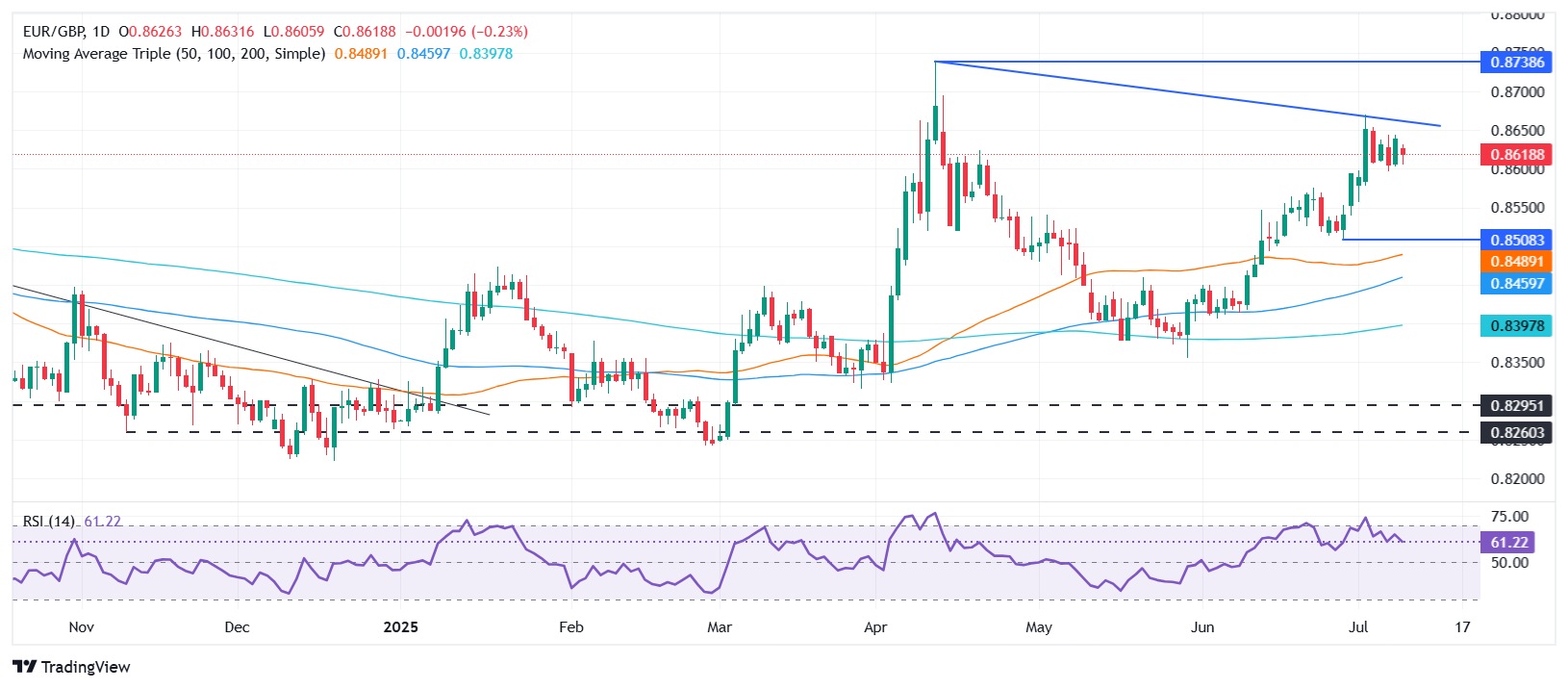EUR/GBP declines as Pound strengthens on UK-US trade deal, EU faces higher tariffs
- Pound gains after UK becomes first to seal trade framework with US.
- Euro pressured as EU faces higher proposed tariffs than UK in talks.
- Traders cautious on UK outlook after welfare bill U-turn fuels fiscal concerns.
The EUR/GBP tumbles during the North American session, down by a 0.18% as risk appetite improved due to most US equity indices registering gains as traders brace for the release of the latest Federal Reserve monetary policy meeting minutes. At the time of writing, the cross trades at 0.8622.
Euro weakens to 0.8622 as markets cheer UK–US deal and eye Fed minutes
Financial markets continued to digest US President Donald Trump's trade war, which threatened to broaden tariffs and impose a 50% tariff on copper, as stated on Tuesday. in the meantime, the Pound Sterling benefits after being the first country to seal a trade framework with its US counterpart.
However, traders remain cautious regarding the Pound following last week’s U-turn on the UK welfare bill, which increases the chances that the government will either increase borrowing or taxes to balance the public accounts.
Earlier, the Bank of England released its financial stability report, in which it flagged that risks remain high due to US tariffs.
In the meantime, negotiations between the EU and the US are showing some progress, though it seems that the EU will face higher tariffs than the UK. The EU has agreed to sign a temporary “framework” that will add 10% tariffs to EU goods, while talks continue.
EUR/GBP Price Forecast: Technical outlook
The daily chart suggests that the EUR/GBP pair is set to consolidate around the 0.8600 figure in the near term, despite the ongoing pullback. Although the downward move appears promising, sellers must clear 0.8600, followed by the 20-day SMA at 0.8567. A breach of the latter will expose the 0.8500 mark.
The Relative Strength Index (RSI) remains bullish but indicates that buyers are losing some momentum.
On the other hand, if buyers hold the pair above 0.8600, expect further upside near a downslope resistance trendline at 0.8650/75, before traders reach 0.8700.

Euro FAQs
The Euro is the currency for the 19 European Union countries that belong to the Eurozone. It is the second most heavily traded currency in the world behind the US Dollar. In 2022, it accounted for 31% of all foreign exchange transactions, with an average daily turnover of over $2.2 trillion a day. EUR/USD is the most heavily traded currency pair in the world, accounting for an estimated 30% off all transactions, followed by EUR/JPY (4%), EUR/GBP (3%) and EUR/AUD (2%).
The European Central Bank (ECB) in Frankfurt, Germany, is the reserve bank for the Eurozone. The ECB sets interest rates and manages monetary policy. The ECB’s primary mandate is to maintain price stability, which means either controlling inflation or stimulating growth. Its primary tool is the raising or lowering of interest rates. Relatively high interest rates – or the expectation of higher rates – will usually benefit the Euro and vice versa. The ECB Governing Council makes monetary policy decisions at meetings held eight times a year. Decisions are made by heads of the Eurozone national banks and six permanent members, including the President of the ECB, Christine Lagarde.
Eurozone inflation data, measured by the Harmonized Index of Consumer Prices (HICP), is an important econometric for the Euro. If inflation rises more than expected, especially if above the ECB’s 2% target, it obliges the ECB to raise interest rates to bring it back under control. Relatively high interest rates compared to its counterparts will usually benefit the Euro, as it makes the region more attractive as a place for global investors to park their money.
Data releases gauge the health of the economy and can impact on the Euro. Indicators such as GDP, Manufacturing and Services PMIs, employment, and consumer sentiment surveys can all influence the direction of the single currency. A strong economy is good for the Euro. Not only does it attract more foreign investment but it may encourage the ECB to put up interest rates, which will directly strengthen the Euro. Otherwise, if economic data is weak, the Euro is likely to fall. Economic data for the four largest economies in the euro area (Germany, France, Italy and Spain) are especially significant, as they account for 75% of the Eurozone’s economy.
Another significant data release for the Euro is the Trade Balance. This indicator measures the difference between what a country earns from its exports and what it spends on imports over a given period. If a country produces highly sought after exports then its currency will gain in value purely from the extra demand created from foreign buyers seeking to purchase these goods. Therefore, a positive net Trade Balance strengthens a currency and vice versa for a negative balance.
